#1st century painting
Text

Wall Fragment with Winged Victory (Nike) (c. 50-79 CE, Boscoreale, Italy)
342 notes
·
View notes
Text

~ Pottery bowl containing paint, once belonging to a fresco painter.
Period: Roman
Date: A.D. 1st century
Place oforigin: Egypt
#ancient#ancient art#history#museum#archeology#roman#ancient history#archaeology#ancient Egypt#egyptology#Egyptian#Egypt#paint#pottery#pottery bowl#1st century
12K notes
·
View notes
Text
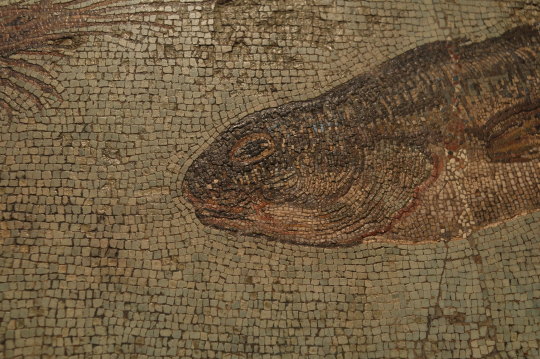
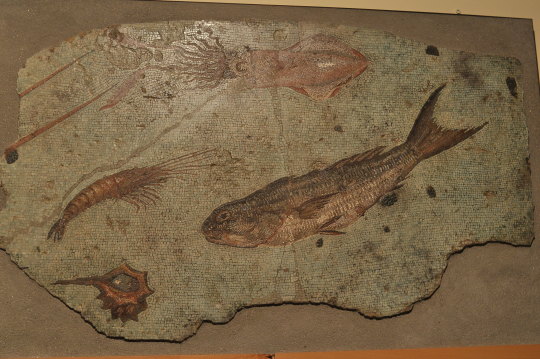
Mosaics da via Panisperna / Mosaics from the Via Panisperna in Rome, late 2nd - early Ist century BC
today at Centrale Montemartini, Rome, Italy
Photos: otdelnovpavel
#ancient rome#mosaic#2nd century bc#1st century bc#europe#secular#ok mosaics aren't wall paintings#italy#fish
4K notes
·
View notes
Text

Acme and Septimius (c. 1868) by Sir Frederic Leighton, 1st Baron Leighton, PRA (British, 1830-1896), oil on canvas, diameter: 99 cm, The Ashmolean Museum of Art, Oxford
#acme and septimius#sir frederic leighton 1st baron leighton pra#frederic leighton#ashmolean museum#oxford#painting#oil on canvas#poem#gaius valerius catullus#catullus#catullus 45#lovers#19th century#academicism#pre raphaelite#aestheticism#my upload
100 notes
·
View notes
Text

Unknown Roman painter, Hercules Finding his son Telephus in Arcadia, from the Augusteum in Herculaneum, early 1st century AD, Julio-Claudian period, fresco (National Archaeological Museum, Naples [inv. 9008])

Detail of the Personification of Arcadia
173 notes
·
View notes
Text

Achilles goblet made of colourless glass with polychrome painting. Height 24.5 cm. 1st half of the 3rd century AD, was found at Richard-Wagner-Strasse 47, in 1991 in Cologne, Germany
The color of the brilliant paint was as fresh as if it had just been applied. The scene painted on glass depicts the "unveiling" of Achilles on Skyros Island. Odysseus managed to find and expose Achilles, who was hidden among daughters of King Lycomedes on Skyros Island. He then took him to the war against Troy, where Achilles was no longer expected to have a peaceful marriage with Déidameia.
34 notes
·
View notes
Text

Portrait of the Empress Josephine (detail), circa 1801
by François Gérard, now at Hermitage Museum
#empress josephine#josephine bonaparte#François Gérard#hermitage#1801#19th century#1800s#napoleonic era#neoclassical#fashion#romanticism#painting#French#art#France#1st empire#empire style#french empire#first french empire#19th century art#empire#romantic#neoclassicism#neoclassical art#dress#dresses#fashion history#historical painting
145 notes
·
View notes
Text
i won't lie to you all, i'm still kind of obsessed with what chris nolan said at the oscars about how films have only been around for ~100 years, how they are still a very new art form, and how we have so much left to do and explore with them. imagine being in only the 1st century of painting, or writing, or sculpture. that's where we are with movies, and that blows my mind a little bit, to be quite honest.
#movies are still new#and i think if everyone remembered that a little more often#we'd be a lot more embracing of all types of movies.#like we created a wholw new art form and its only been around for a *fraction* of the time as anything else#idk why im so sentimental about this on this thursday eve#but like !! we are making and talking about the first movies still !!#in 500 years or 1000 years people will still be making movies and itll be so different#but theyll still be telling stories through a medium we were there for the 1st century of yknow 🥹🥹#like imagine early humans seeing the paintings made 1000 years later#or 10000 years later !! and seeing how we still put pigment to a canvas#sorry please ignore all of this
3 notes
·
View notes
Photo

El ataque a La Goleta
by Frans Hogenberg (Flemish, c. 1540 – 1590)
after Jan Cornelisz. Vermeyen (Hollandian, circa 1504 –1559)
via Wikimedia Commons
#718936799839469568/WBrdzhe0#Frans Hogenberg#[copy after]#Jan Corneliszoon Vermeyen#Jornada de Túnez#Monarquía Hispánica#Spain#Kingdom of Portugal#16th century#Renaissance#1535#June 1st#engravings#military#paintings
3 notes
·
View notes
Text



Etruscan paintings from the Tomb of the Triclinium (estimated to have been built around 470 BC), as painted by Carlo Ruspi (1798-1863)
#anonymous#carlo ruspi#1st century bc#etruscan art#painting#human figure#ornament#sketch#mural painting#antiquity
1 note
·
View note
Text

Roman Terracotta antefix, early 1st century AD.
Antefixes are decorative covers for the ends of tiles situated at the edge of a roof. This showing Venus the goddess of love, and her lover Mars the god of war, retains amount of its painted surface.
567 notes
·
View notes
Text

Wall painting on black ground - Aedicula with small landscape, from the imperial villa at Boscotrecase (1st century B.C.)
76 notes
·
View notes
Text

Medallion painting of Venus Aphrodite with a golden diadem and scepter, pearl earrings and necklace, House of Marcus Fabius Rufus, Pompeii. 1st century BC
2K notes
·
View notes
Text
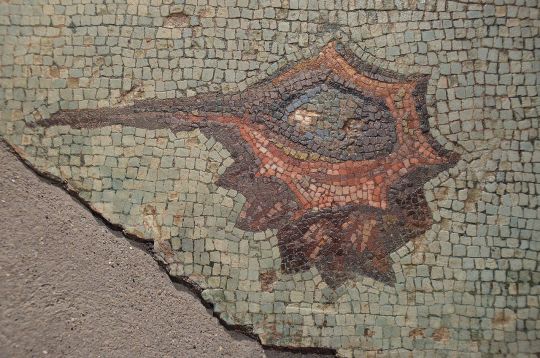


Mosaics da via Panisperna / Mosaics from the Via Panisperna in Rome, late 2nd - early Ist century BC today at Centrale Montemartini, Rome, Italy
Photos: Carole Raddato / wikimedia commons / CC BY-SA 2.0
#ancient rome#mosaic#2nd century bc#1st century bc#fish#europe#secular#italy#ok mosaics aren't wall paintings
968 notes
·
View notes
Note
A big thanks to you and your team for making Pentiment, it's an amazing game and it'll be with me for a long time I think, especially the personal and emotional character writing.
I'm curious about what was the inspiration behind, and creative motivation for including, the motif of the labyrinth. The church's painting of the Virgin Mary with the labyrinth seems striking in particular, especially because I don't remember ever coming across a strong association with labyrinths in Christian imagery.
Thank you. I'm glad it was so impactful.
Labyrinths have a long association with Christianity going back to the 4th century, when one was placed in a cathedral in Chlef (now in Algeria). This is known as the St. Reparata or St. Reparatus Labyrinth.

The Chartres Labyrinth was built around 1200.
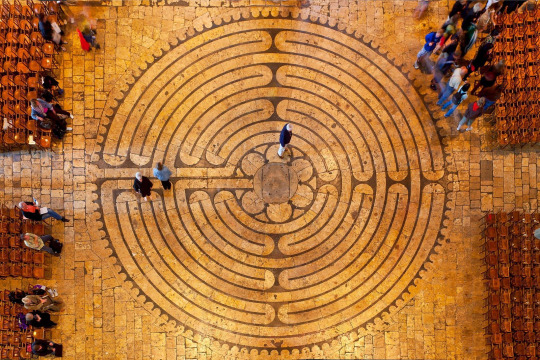
Christian labyrinths are meant to be walked while contemplating. The path twists and turns, but there is only one way to go. They also all clearly take inspiration from labyrinths of the classical world even if their purpose and origins are effectively lost to those who see them.
As Beatrice says to Andreas (paraphrased), the foundations of our memories become buried and invisible. And she is paraphrasing and abbreviating Plato speaking to Solon in Timaeus,
whatever happened either in your country or in ours, or in any other region of which we are informed-if there were any actions noble or great or in any other way remarkable, they have all been written down by us of old, and are preserved in our temples. Whereas just when you and other nations are beginning to be provided with letters and the other requisites of civilized life, after the usual interval, the stream from heaven, like a pestilence, comes pouring down, and leaves only those of you who are destitute of letters and education; and so you have to begin all over again like children, and know nothing of what happened in ancient times, either among us or among yourselves. As for those genealogies of yours which you just now recounted to us, Solon, they are no better than the tales of children. In the first place you remember a single deluge only, but there were many previous ones;
I also wanted the association with the labyrinth from The Name of the Rose, which in turn was inspired by the Reims Labyrinth.
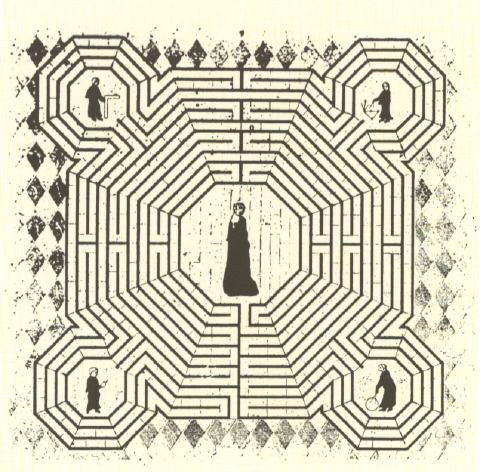
The Reims Labyrinth was constructed in the late 13th century but was destroyed in the 18th century by superstitious priests. It was through the discovery of drawings that modern scholars were able to recreate and project the path of the labyrinth onto the cathedral floor.

The cover of the 1st Italian edition (and therefore, first edition overall) of Il Nome della Rosa prominently incorporated the drawing of the Reims Labyrinth.

Note the map of the Aedificium:

The final lines of The Name of the Rose are:
Stat rosa pristina nomine, nomina nuda tenemus.
The original rose remains only in name, we hold those names stripped.
This refers to a specific object in the story, but more broadly symbolizes historical records, art objects, and other artifacts lost to time. The Reims Labyrinth remains only in drawings, stories, and light projected on the ground where it once stood; the labyrinth itself was destroyed.
Nomen est; res non est. - The name exists; the thing does not.
As a side note, France uses the Reims Labyrinth as its symbol for historical monuments - an important reminder of how fragile their existence can be.

1K notes
·
View notes
Text
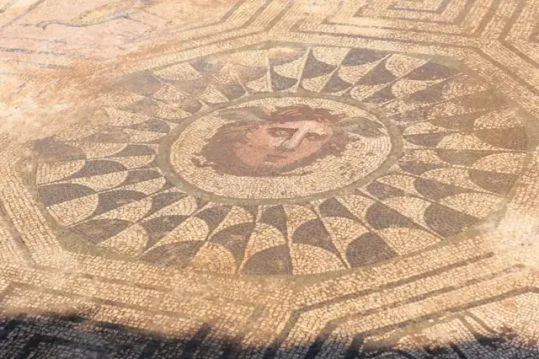
Archaeologists Unearth Ancient Mosaic of Winged Medusa in Spain
The stunningly preserved Ancient Roman mosaic floor was found at the Huerta de Otero site in the city of Mérida.
In both ancient and modern interpretations, Medusa is often known as a monster — a Gorgon with tresses of serpents whose stare turned men to stone. This version typically appears in children’s movies and fantasy thrillers, but her image hasn’t always been so awe-inspiring. In late June, archaeologists in Western Spain uncovered an Ancient Roman mosaic floor that depicts Medusa with tiny wings and flowing locks of hair, thought to have been used as a protective symbol.

The mosaic was found in the city of Mérida’s Huerta de Otero archaeological site. Ancient Romans established a colony there in 25 BCE named Augusta Emerita. Traces of its former inhabitants — including an amphitheater and a bridge — can be found throughout the modern-day city. “[The site] is of an exceptional nature due to the level of conservation of the ruins and, above all, the ornamental elements that decorate the well-preserved house: not only the mosaic of the Medusa but also paintings and sculptural motifs,” said archaeologist Félix Palma in a statement.
The Huerta de Otero location was excavated in 1976 but lay untouched for decades. Research picked back up in 2019, when the city employed professional archaeologists and students from its Barraeca II Professional School to explore the ruins. Since then, the team has uncovered an Ancient Roman defensive wall, a road, and the home of a wealthy family.
The Medusa mosaic adorned the floor of this home. Depictions of fish, peacocks, and carefully tessellated patterns surround the artwork’s central figure: a human-like Medusa, her gaze turned to one side.
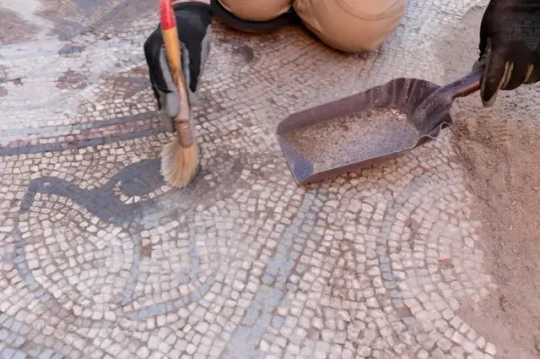
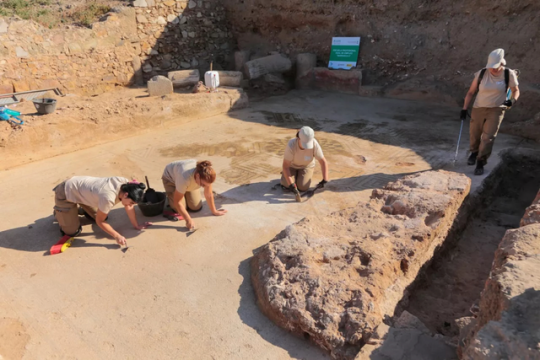
Although this image diverges from some contemporary renditions of the mythological figure, the mosaic’s winged version was common in Ancient portrayals of Medusa. While early Greek depictions of the mortal-turned-monster, cruelly punished for being raped by the god Poseidon, show her as grotesque, Medusa’s image softened by the time of the Ancient Romans. Beginning in the Classical Greek period, her face acquired more human attributes. It started to be rendered with symmetry and youthful beauty in the following centuries.
Other Ancient Roman mosaics featuring the head of Medusa have been discovered throughout Spain. Medusa again comprises the focal point of an Ancient Roman mosaic in a 115–150 CE work found in Rome, where she can be seen sporting human curls and a snake around her neck. A 1st-to-2nd-century ornament from a chariot pole shows a young woman with curly locks (although a couple of snakes still peer through her tangle of hair).
In Ancient Greek mythology, Perseus killed Medusa to avoid being turned to stone. Medusa, in her early terrifying form, was used as a protective symbol — “an image of evil to repel evil,” Madeleine Glennon writes in a 2017 essay for the Metropolitan Museum of Art. The goddess Athena famously included a representation of Medusa’s severed head on her protective cloak or aegis. In Ancient Rome, her beautified image was still employed as a protective symbol, although the depiction shifted into a form more similar to a woman than a monster.
By Elaine Velie.

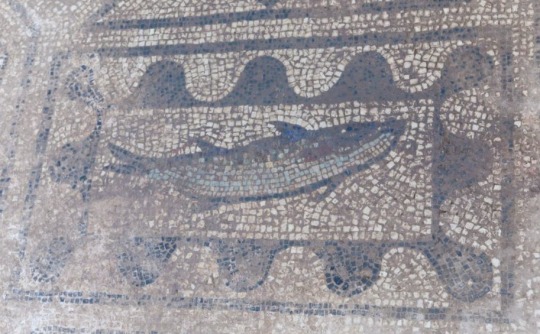
#Archaeologists Unearth Ancient Mosaic of Winged Medusa in Spain#mosaic#roman mosaic#Mérida Spain#Huerta de Otero archaeological site#ancient artifacts#archeology#archeolgst#history#history news#ancient history#ancient culture#ancient civilizations#roman history#roman empire#roman art
602 notes
·
View notes